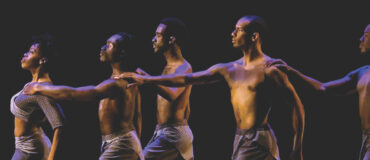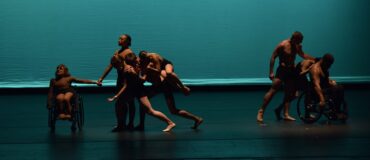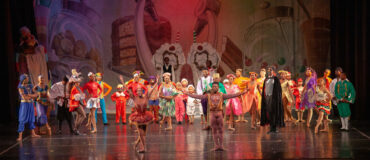by shady Radical
shady Radical is a 2022 Archiving and Preservation Fellow with Ballethnic Dance Company. Read more about the Fellowships here. This is the third part of shady’s blog. Read the second part here.
December 15, 2022: Building an Archive: Overview and Advice
I. Introduction
Over the course of this Fellowship I have been working closely with Ballethnic’s co-founder and artistic director, Waverly T. Lucas, whom people affectionately call Mr. Waverly. He is the creative energy driving the Company and Academy. As a professionally trained dancer, choreographer, and ethnochoreologist, Mr. Waverly was extremely essential to the design and organization of the archive. As a fundamental principle of archival science, the shape and form of the archive should follow its contents and materials. In other words, the structure of the archive and its access points should reflect what sort of materials are found there.

Urban Nutcracker Act II Chocolate Pas de Deux. The original Chocolatier and Brown
Sugar (Waverly Lucas and Nena Gilreath). Photography by Keiko Guest
Prior to establishing Ballethnic, Mr. Waverly received training in his hometown, Detroit, at Interlochen Center for the Arts and Marygrove College, before dancing with Alvin Ailey American Dance Theater, Dance Theatre of Harlem (DTH), Heartstrings, and Atlanta Ballet. At DTH he met Nena Gilreath who would become the founding partner of Ballethnic Dance Company in 1990. Mr. Waverly and Ms. Nena relocated to Atlanta after being offered contracts from Atlanta Ballet. After dancing with Atlanta Ballet, they left frustrated by how they were being treated and by the lack of opportunities for Black dancers in the company, productions, and in Atlanta generally, a community with a large Black population and leadership. In a meeting with Mr. Richard Long, a pioneering scholar of African American arts and culture, they were discussing the possibilities to start a ballet company that centered the Black body and experience, however they ended up being convinced to lead the charge and start the company they proposed.
Before long, Mr. Waverly and Ms. Nena started Ballethnic and performed as part of different programs to pave the way for the new company. Dr. Pearl Primus of the Dance Department at Spelman College offered them rehearsal space. As also made clear in Shocarra Marcus’s recent documentary 5 Stories (2022), at one point in the history of Black dance in Atlanta every little girl who danced was dancing at Spelman College.
II. Collection
When I began working with Ballethnic, Mr. Waverly gave me several plastic bins of video cassettes, BETA tapes, CDs/DVDs, storage drives, photographs, certificates, show programs, t-shirts, and posters. You could tell the bins had been sitting in places for a long period of time due to the presence of dead critters, but they also reflected intentionality in preservation. These materials were collected together and preserved because they were understood as historically relevant to the company and/or work Mr. Waverly and Ms. Nena were doing.
We also decided on a deadline for adding new materials to the collection. With a company as old as Ballethnic it is common that workers, dancers, parents, affiliates of the company will find and offer material that is extremely relevant to the history of the company. In order to continue to establish a structure and continue to move forward it is good to establish a collection cut off.

Urban Nutcracker Act II. Black Russian. Dancer: Chad Jones. Photography by Sirk Photography.
III. Organization
First I opened everything and organized it based on the type of material. Next, I labeled the boxes with bright pink tags and created a simple inventory of everything on a spreadsheet. I posted this inventory on the wall and used it as a reference on my laptop. At this point, my project mentor Derek Mosley, archivist at Auburn Avenue Research Library, visited Ballethnic to offer direction and archival advice. Together we made a list of materials to purchase to assist me in proceeding to the next level of organization. We ordered plastic CD/DVD cases, cardboard boxes, legal size folders, tape, and rubber bands.
As I started to go through the boxes again I added another layer of description. I entered information according to each item into a database and attached a sticky note to the item to correspond to the information in the database. I worked on the audiovisual materials first because from the first round I saw that they were in various states of deterioration (i.e. mold). I also removed materials from the plastic bins and placed them in cardboard bins. While these bins were smaller, they were also more lightweight and breathable, which helps with transport and preservation.
IV: Cataloging
To catalog the physical materials I used Google spreadsheets. I created columns for information I gleaned from the physical material like the year it was created/performed, presenting institution, title, type, venue, condition, and notes. I also created an ID number for each item. After a zoom session with artist, educator, and consultant David Thomson organized by Dance/USA, in which he presented about the Trisha Brown Dance Company database that he helped design and build, I met with Mr. Thomson about the database I was building. I was looking for some insight on how detailed the database needed to be at my current point of organization. He assured me that my system was sufficient and offered me a formula that would standardize and automate the numbering based on when items entered the database. This would help keep track of the condition and location of multiples no matter when they entered the database. This was extremely helpful in organizing the AV materials.

Urban Nutcracker Act I. Snow King and Queen (Calvin Gentry and Karla Tyson) at the City of East Point City Hall. Photography by lenzcapd photography
Since there were many different types of paper material, I resorted to taking these materials home and working on them at night. My homeplace was surprisingly a really nice environment to process these works due to the nature of the material. I found programs, notes, cards, etc. from the early days of Ballethnic full of sentimental value providing insight into the many relationships that they have nurtured and sustained over the years.
V: Conclusion
As I conclude this Fellowship, I am finishing up with entering the organized materials into the database. The challenge with this part of the process is tying up loose ends in a way that will offer the person who takes over my role easy access to the materials. I am thinking about tools and information that would be helpful to me if I were entering into a new relationship with a company. The first piece of advice I would offer is get to know the people first so that you can understand what is really significant to the story you are helping to tell. Next, build a relationship with the facilitator of the project, and lastly plan and execute. Do not be afraid to pivot, ask questions, or be quiet and just observe. These are skills I center in working with Black production or performance companies, but that should be used when working with all companies that rely on improvisation and embodied knowledge as a major resource and mode of production.
Top photo: Finale bows Urban Nutcracker Act II (Cast). Photography by Sirk Photography. Courtesy of Ballethnic Dance Company.
 shady Radical is a performance archivist and founder of The Radical Archive of Preservation. Her practice is grounded in ritual, resistance, and movement practices. She uses exhibition and performance to pull anarchival material out of traditional archives and historical memory to activate silences and erasures attributed to forms of subjugation.
shady Radical is a performance archivist and founder of The Radical Archive of Preservation. Her practice is grounded in ritual, resistance, and movement practices. She uses exhibition and performance to pull anarchival material out of traditional archives and historical memory to activate silences and erasures attributed to forms of subjugation.
As a Fellow, shady looks forward to working with a nationally recognized southern institution committed to expanding access to professional dance opportunities for people of color. By combining ballet with African dance and other forms, Ballethnic directly contributes to the Black cultural production shady is most interested in studying, knowing, and preserving.
shady earned a M.A. in Curatorial Studies from New York University and B.A. in Art History from The College of Saint Elizabeth. Her professional experience includes working at Tyler Perry Studios, Atlanta Contemporary, and Assistant Chair for Society of Georgia Archivists’ Education Committee. shady is a Ph.D candidate at Georgia State University.
____
We accept submissions on topics relevant to the field: advocacy, artistic issues, arts policy, community building, development, employment, engagement, touring, and other topics that deal with the business of dance. We cannot publish criticism, single-company season announcements, and single-company or single artist profiles. Additionally, we welcome feedback on articles. If you have a topic that you would like to see addressed or feedback, please contact communications@danceusa.org.
Disclaimer: Opinions expressed in guest posts do not necessarily represent the viewpoints of Dance/USA.





